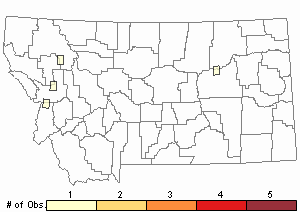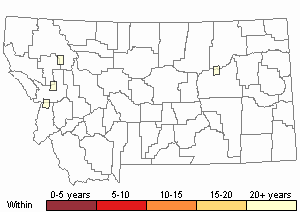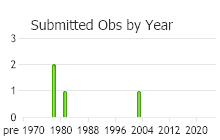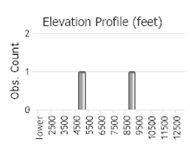View in other NatureServe Network Field Guides
NatureServe
Montana
Utah
Wyoming
Idaho
Wisconsin
British Columbia
South Carolina
Yukon
California
New York
Acuteleaf Dicranum Moss - Dicranum acutifolium
General Description
Plants: Dense to loose tufts, light green to light brown, dull. Stems 1.5-7.0 cm, usually branched and little tomentose with red-brown rhizoids.
Leaves: Erect-spreading. When dry little curled to somewhat straight. Lanceolate, narrowly acute to acuminate, 3.5-10 x 0.5-1.0 mm. Distal portion with some undulations and keeled, basal portion concave. Margins somewhat involute, serrulate/serrate. Costa percurrent to slightly excurrent with 1/6 to 1/4 the width of leaf base.
Leaf Cells: Cells smooth or weakly papillose (abaxial side). Alar cells differentiated and usually extend to costa. Proximal laminal cells long-rectangular, pitted. Distal laminal cells short-rectangular, irregularly angled or rounded, and not pitted. X-S: 1-layer though sometimes 2-layers in the distal margins and alar cells are 2-layer; Cell walls are not or slightly bulging lamina cells. Costa X-S: 1 row of guide cells, 2 rows of stereid bands extending to the apex. Adaxial epidermal cell layer not differentiated, but abaxial epidermal cell layer differentiated.
Phenology
Capsules ripen in summer (FNA 2007).
Diagnostic Characteristics
Dicranum acutifolium is frequently confused with D. fuscescens, but the latter has a rougher and longer needle-like awn that, in X-section of the upper half, is shown to have noticeably larger papillae compared to the more obscure ones of D. acutifolium. Additionally, the margins of D. fuscescens are almost entirely 2-layered, whereas in D. acutifolium, they are mostly 1-layered (FNA 2007).
D. brevifolium also resembles D. acutifolium, but the dry leaves of D. brevifolium are crisped and spread very widely from the stem, and its conspicuous costae are prominently rounded; the dry leaves of D. acutifolium, on the other hand, are a little curled and erect-spreading, and its somewhat distinct costae are nearly flat on the outer surface (FNA 2007).
Range Comments
In northern latitudes of British Columbia, Alaska, Greenland, Ontario, Quebec, Montana, and Alberta (Elliott and Moore 1989). An arctic-alpine species from Alaska, Yukon and the Northwest Territories, Greenland, and Newfoundland, south in the western mountains to Alberta and British Columbia, in the East to Quebec and Ontario. Widespread in the mountains of Europe; arctic Asiatic USSR; central Asia (Steere 1978). In Montana, known from Flathead, Glacier, Madison, Ravalli, and Valley Counties (Elliott 2016).
Observations in Montana Natural Heritage Program Database
Number of Observations: 4
(Click on the following maps and charts to see full sized version)
Map Help and Descriptions
Relative Density

Recency



 (Observations spanning multiple months or years are excluded from time charts)
(Observations spanning multiple months or years are excluded from time charts)
Habitat
Slightly calcareous soil, boulders, rock outcrops, cliff ledges, occasionally humus, and rarely rotten logs. 2200 to 8300 feet (FNA 2007).
Reproductive Characteristics
Seta is 1.2-2.5 cm tall, single, yellow to red-yellow. Capsules are 2-2.7 mm long, arcuate, inclined or horizontal, furrowed (dry), and brown to red-brown. Dwarf males occur on the stem rhizoids of female plants.
Stewardship Responsibility
References
- Literature Cited AboveLegend:
 View Online Publication
View Online Publication Elliott, J. C. and G. L. Moore. 1989. Additions to the Moss Flora of Montana. The Bryologist 92(2):194-197.
Elliott, J. C. and G. L. Moore. 1989. Additions to the Moss Flora of Montana. The Bryologist 92(2):194-197. Elliott, J.C. and A.K. Pipp. 2018. A Checklist of Montana Mosses (1880-2018). Updated 3 January, 2020. Montana Natural Heritage Program, Helena, Montana. 73 pp.
Elliott, J.C. and A.K. Pipp. 2018. A Checklist of Montana Mosses (1880-2018). Updated 3 January, 2020. Montana Natural Heritage Program, Helena, Montana. 73 pp. Flora of North America Editorial Committee, eds. 2007. Flora of North America North of Mexico. Volume 27. Bryophytes: Mosses, Part 1. Oxford University Press, Inc., NY. xxi + 713 pp.
Flora of North America Editorial Committee, eds. 2007. Flora of North America North of Mexico. Volume 27. Bryophytes: Mosses, Part 1. Oxford University Press, Inc., NY. xxi + 713 pp. Steere, William. 1978. The Mosses of Arctic Alaska. J. Cramer, Liechenstein.
Steere, William. 1978. The Mosses of Arctic Alaska. J. Cramer, Liechenstein.
- Additional ReferencesLegend:
 View Online Publication
View Online Publication
Do you know of a citation we're missing? Elliot, J. C. 1993. Second checklist of Montana mosses. Unpublished report. U.S. Forest Service, Region 1. Missoula, MT. 45 pp.
Elliot, J. C. 1993. Second checklist of Montana mosses. Unpublished report. U.S. Forest Service, Region 1. Missoula, MT. 45 pp. Lawton, E. 1971. Keys for the Identification of the Mosses on the Pacific Northwest. Reprinted from 'Moss Flora of the Pacific Northwest'. Published as Supplement No. 2 of the Journal of the Hattori Botanical Laboratory. Nichinan, Miyazaki, Japan. 66 pp.
Lawton, E. 1971. Keys for the Identification of the Mosses on the Pacific Northwest. Reprinted from 'Moss Flora of the Pacific Northwest'. Published as Supplement No. 2 of the Journal of the Hattori Botanical Laboratory. Nichinan, Miyazaki, Japan. 66 pp. Lawton, E. 1971. Moss Flora of the Pacific Northwest. Hattori Botanical Laboratory. Japan: Yamabuki-cho, Shinjuku-ku, Tokyo. 362 pages plus appendices.
Lawton, E. 1971. Moss Flora of the Pacific Northwest. Hattori Botanical Laboratory. Japan: Yamabuki-cho, Shinjuku-ku, Tokyo. 362 pages plus appendices.
- Web Search Engines for Articles on "Acuteleaf Dicranum Moss"





